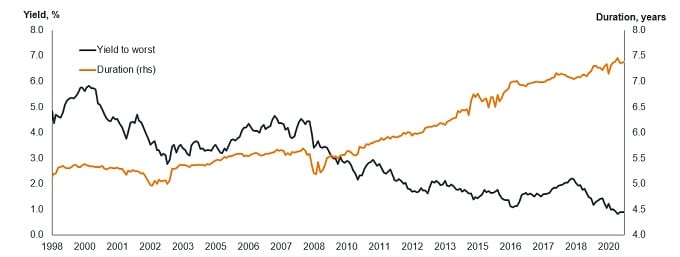Subscribe
Sign up for timely perspectives delivered to your inbox.
Colin Fleury, Head of Secured Credit London, says a relatively constructive view for credit markets may seem strange, but there are reasons he believes stress in the markets will be manageable.
With many parts of the world currently dealing with the implications of a second spike in COVID‑19 cases, it feels somewhat strange to hold a relatively constructive view for credit markets generally in 2021.
Short‑term growth challenges certainly remain, but the aggressive actions of governments and central banks have substantially moderated the corporate and consumer credit default outlook in our view, and market technical demand is generally expected to be strong as investors seek incremental yield opportunities.
There will certainly be instances of companies with unsustainable levels of borrowing, taken on to provide needed liquidity through the pandemic, that will need to restructure. Eventually governments will dial back emergency support packages for individuals that will lead to rising levels of consumer credit delinquency and this needs to be factored into our stress assumptions when investing in securitised markets. However, overall, we believe both will remain at manageable levels.
While the diversification benefits of holding fixed rate bonds (the prices of which rise as interest rates fall) within balanced equity/bond portfolios was far lower during the Q120 sell‑off than perhaps would have been enjoyed through such volatility historically, overall interest rate moves have still been a significant contributor to total returns of fixed rate asset classes in 2020.
Year‑to‑date*, total returns of 7.1% (in US dollar hedged terms) for global investment grade bonds all came from interest rate moves. Excess returns, excluding such moves, were essentially flat. In global high yield, it has been a similar story, 3.7% total returns, although excess returns were negative at ‑1.1%.
While the debate as to what extent central bank and fiscal stimulus will ultimately drive up inflation remains very alive, it certainly feels that the distribution of risk is towards higher, rather than lower, rates. This is combined with levels of duration in typical bond portfolios that are elongated by historical standards (magnifying the potential market price impact of interest rate moves) – see chart.

At the same time, while the aggressive actions of central banks have been critical to the maintenance of global financial stability during these unprecedented times, many investors find themselves now searching for ways to sensibly add yield into portfolios in 2021.
Faced with the above, we believe floating rate securitised investments and secured loans have an important role to play in diversified credit portfolios. Relative investor appetite will depend on their risk tolerance and return requirements, with securitised assets — a mainly investment grade market — considered as an alternative to corporate bonds, and secured loans viewed as a sub investment grade alternative to high yield.
It is also often the case that both markets can offer extra credit spread return versus their fixed rate relatives, helping to address the incremental search for yield. With the diversification benefits of core fixed income portfolios more questionable for the reasons highlighted above, while not negatively correlated, we do believe such floating rate asset classes can bring lower correlation benefits.
One consideration, however, is the typically greater call optionality in favour of the borrower in securitised and loan markets, which limits the opportunity for market prices to rise above par (realising capital gains for the investor).
So, perhaps the right answer for many is to build a diverse portfolio that has some protection against interest rate increases. This could be through a decent allocation to floating rate loans and securitised assets, combined with fixed rate high yield with greater call protection and where there has been a robust story through COVID‑19 providing an opportunity for income to be supplemented by mark‑to‑market gains. This is certainly our view.
*Year‑to‑date to 19 November 2020